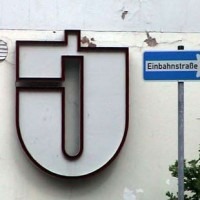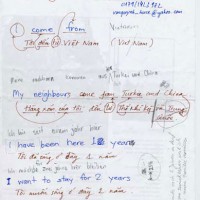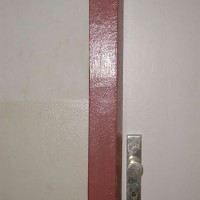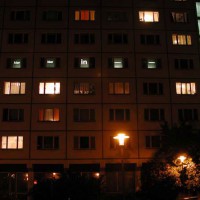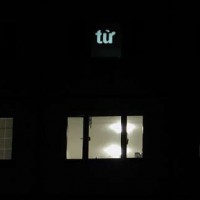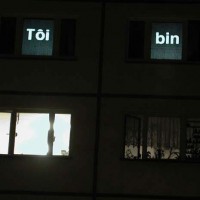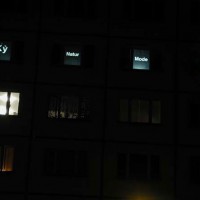Contact Zone – Transculturation
Materials:
Slides and slide projectors.
Concept:
An effect of globalisation, is the development of new locations of transculturation. The ‘Jacob’ student residence can be viewed as such a site of cultural intersection. The collection, visualisation and affirmation of this rich multiculturalism form the basis of a temporary site installation.
Flanagan worked closely with the residents of the building, their language and their customs, to produce a series of multi lingual texts projected at night from the fifth floor windows, to assert to the wider community the presence of this diverse growing culture. A rhythm develops throughout the forty-minute sequence that flows initially from horizontal word formations to eight simultaneous texts read vertically across the sequence band.
The temporal nature of the intervention projects itself into the local and resident communities rather than to a traditional art market. The colloquial language and common subject matter are tactics used to communicate with local people, on the street. The projections run through a series of statements in German and then repeat in the native language of the tenant.
The development process and the unannounced implementation, engaged with underlying circuits of communication, gossip and word of mouth networks that operate effectively within small communities such as Weimar, with a population of 61,000.
Contact zone is a term adapted from sociolinguistics, used by Mary Louise Pratts10 in the essay ‘Imperial Eyes’ to define contact languages such as pidgins and Creoles, which emerge in historical conjuctures. ‘Transculturation’ is used by the Cuban ethnographer Fernando Ortiz11 to describe a perspective that does not see culture as a colonialist vision of progression, where one culture replaces another (sometimes violently), instead it is viewed as relational ensembles developed and sustained through a continual process of cultural borrowing. Growth ensues through re-appropriation and translation – a multi directional process, a rhizome12 development – it is a network with no hierarchical centre.
Such a potential melting pot is envisioned within the eleven-storey ‘plattenbau’ (German prefabricated concrete slab constructed blocks of units) locally referred to as ‘The Jacob’. It has been a site of multi-cultural engagement since its foundation as a student residence in 1993. The fact that before 1989 Weimar, being part of the eastern block, was largely closed to such influences makes this location particularly potent.
The broad range of cultures represented within the building are indicative of a cross section of an anthropological phenomena that is evident globally (at least in first world countries), where a generation is more that ever before mobilised, engaging, communicating, making contact with the rest of the world, the development of and awareness of the “other” of one’s self or culture is proliferated.
Jacobsplan was built in the 1970’s and is the only example of plattenbau architecture in Weimar. It is the tallest building and the cheapest student dormitory in the city. It houses students from all over the world mainly from Eastern Europe and Asia but also Germans.
Flanagan moved into an apartment on the fourth floor for one month to work closely with the tenants to create ‘Contact Zone – Transculturaltion’. The nationalities involved were Australian, Turkish, Swedish, Vietnamese, Chinese, and three Germans.
Weimar’s history makes it somewhat of a Mecca for Neo Nazis. One week before the planned event a letter arrived from the Housing Authority that controls the building, cancelling the agreement to produce the installation on the grounds that it may incite Neo Nazi violence. All work was stopped. After getting letters of support from all the tenants and after long negotiations with the authorities we were given permission to proceed.
Project Partners:
Office of Housing – Jena
Jacobsplan Residents
The Bauhaus University Weimar
Exhibitions:
Public Performance Jacob Straße, Weimar, 2003.
Installation in Kino CineStar (movie theatre), Schützengasse 14, Weimar Germany, 2003.
Publications:
FLANAGAN, T. (2004) Transculturation. IN HOHMANN, K., WEBER, L., REICHMANN, J. & BAUM, H. (Eds.) Public Art and New Artistic Strategies. Weimar, Bauhaus University Weimar, University Publishers. Pp. 70 – 71.
Thanks:
- Christian Hasucha
- Leonie Webber
- Professor Liz Bachhuber
- The Bauhaus University – Weimar
Endnotes:
10. PRATT, M. L. & EBOOKS CORPORATION. (1992) Imperial eyes : travel writing and transculturation, London ; New York, Routledge.
11. “I am of the opinion that the word transculturation better expresses the different phases of the process of transition from one culture to another because this does not consist merely in acquiring another culture, which is what the English word acculturation really implies, but the process also necessarily involves the loss or uprooting of a previous culture, which could be defined as a deculturation. In addition it carries the idea of the consequent creation of new cultural phenomena, which could be called neoculturation.” ORTIZ, F. (1995) Cuban counterpoint, tobacco and sugar, Durham, Duke University Press. Pp. 102 – 3.
12. DELEUZE, G. & GUATTARI, F. L. (1987) A thousand plateaus : capitalism and schizophrenia, Minneapolis, University of Minnesota Press.
